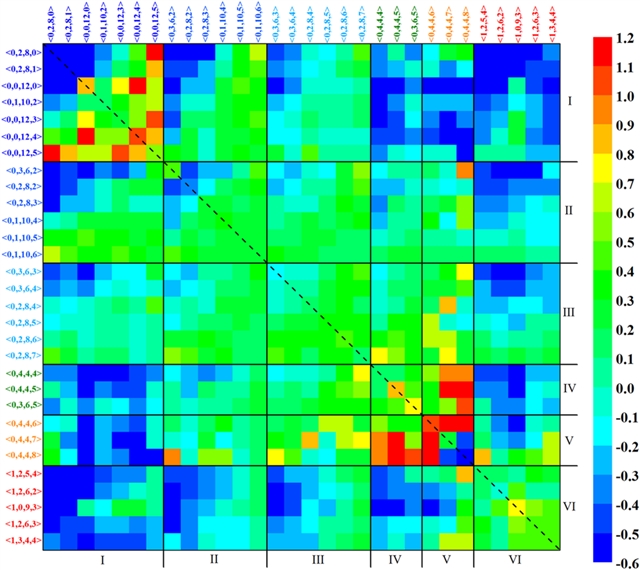论文标题:Nanometer-scale gradient atomic packing structure surrounding soft spots in metallic glasses
期刊:npj Computational Materials
作者:Binbin Wang et al
发表时间: 2018/7/30
数字识别码:10.1186/s41524-018-0097-4
原文链接:https://www.nature.com/articles/s41524-018-0097-4?utm_source=Other_website&utm_medium=Website_linksWebsite_links&utm_content=JesGuo-Nature-npj_Computational_Materials-Materials_Science_of_Multidisciplinary-China&utm_campaign=NPJ_USG_JRCN_JG_Nanometer
金属玻璃:梯度原子堆垛与可塑性
梯度原子堆垛结构中的液体状原子可能决定金属玻璃的可塑性。来自中国哈尔滨工业大学的Yanqing Su和美国加州大学伯克利分校的Robert Ritchie领导的团队,采用分子动力学模拟来根据原子的堆积对不同金属玻璃中的原子进行分类,从而解释了金属玻璃的非晶态中程序列特征。他们发现局部原子结构,通过类液态区,过渡区和类固态区逐渐从松散的原子堆垛转变为致密的原子堆垛,类液态原子及其相邻部分相当于“软区”,并与局部不可逆转原子重组的引发有关。对这种梯度原子堆积结构进行建模可以帮助我们更好地理解和设计玻璃合金的可塑性。
摘要
长期以来,非晶结构中原子堆垛的隐藏顺序,及其如何为塑性结果提供起源,一直是理解金属玻璃中塑性变形的目标。为了解决这一问题,我们采用分子动力学模拟的方法,为一些金属玻璃创建三维模型,并基于配位多面体的几何阻挫,将非晶结构中的原子分为六个不同的种类,其中存在着“梯度原子堆积结构”。非晶态的局部结构可以展现出从松散原子堆垛到密集原子堆垛的逐渐过渡,随后是原子性能的梯度演变。因此,非晶态合金具体包括三个可辨别的区域:类固态区,过渡区和类液态区,每个区域具有不同类型的原子。此外,我们还发现类液态原子与剪切转化的可育部位相关性最高,过渡原子排在第二位,而类固态原子由于它们与类液态原子的相关性最低而贡献最小。与不考虑中程序列特征的“几何上不受欢迎图案”模型不同,我们的模型为所谓的“软区”提供了一个明确的结构,即类液态原子和它们相邻部分的组合,有利于量化和比较不同金属玻璃之间的软区数量,这可以为金属玻璃的独特机械性能提供一个合理的解释。

不同类型原子的相关性矩阵。
Abstract:
The hidden order of atomic packing in amorphous structures and how this may provide the origin of plastic events have long been a goal in the understanding of plastic deformation in metallic glasses. To pursue this issue, we employ here molecular dynamic simulations to create three-dimensional models for a few metallic glasses where, based on the geometrical frustration of the coordination polyhedra, we classify the atoms in the amorphous structure into six distinct species, where “gradient atomic packing structure” exists. The local structure in the amorphous state can display a gradual transition from loose stacking to dense stacking of atoms, followed by a gradient evolution of atomic performance. As such, the amorphous alloy specifically comprises three discernible regions: solid-like, transition, and liquid-like regions, each one possessing different types of atoms. We also demonstrate that the liquid-like atoms correlate most strongly with fertile sites for shear transformation, the transition atoms take second place, whereas the solid-like atoms contribute the least because of their lowest correlation level with the liquid-like atoms. Unlike the “geometrically unfavored motifs” model which fails to consider the role of medium-range order, our model gives a definite structure for the so-called “soft spots”, that is, a combination of liquid-like atoms and their neighbors, in favor of quantifying and comparing their number between different metallic glasses, which can provide a rational explanation for the unique mechanical behavior of metallic glasses.
阅读论文原文,请访问
https://www.nature.com/articles/s41524-018-0097-4?utm_source=Other_website&utm_medium=Website_linksWebsite_links&utm_content=JesGuo-Nature-npj_Computational_Materials-Materials_Science_of_Multidisciplinary-China&utm_campaign=NPJ_USG_JRCN_JG_Nanometer
(来源:科学网)
特别声明:本文转载仅仅是出于传播信息的需要,并不意味着代表本网站观点或证实其内容的真实性;如其他媒体、网站或个人从本网站转载使用,须保留本网站注明的“来源”,并自负版权等法律责任;作者如果不希望被转载或者联系转载稿费等事宜,请与我们接洽。